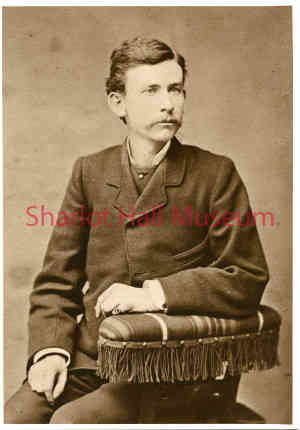By Marjory J. Sente

On January 1, 1887, the citizens of Prescott and its leaders were jubilant. The iron horse on that New Year’s Day connected the once-isolated Arizona town with the outside world. Although the Prescott and Arizona Central Railroad (PACR) had a rocky beginning and an even rougher demise, it arrived on time.
Celebrations actually started the previous day when the PACR’s track that passed Fort Whipple brought the first locomotive to a 22-gun salute and musical greetings from the fort’s band.
January 1 was sunny and warm, with 60-degree temperatures in the shade. Festivities began at 10:30 A.M. with a procession of the local militia and citizens, fire companies, civic societies, and a detachment and band from Whipple marching from Cortez Street to the depot on the north side of town. There a 100-gun salute and cheering people greeted two steam locomotives, the Pueblo and F.A. Tritle, as they approached with bells ringing and whistles blowing.

The day’s program started with laying the last tie painted red and white, followed by Governor C. Meyer Zulick hammering in a gilded spike. This ceremonial act completed the nearly 75-mile branch line from Prescott Junction (Seligman) to Prescott on the transcontinential Atlantic and Pacific Railroad. The governor noted, this was a “new epoch in the progress of Arizona.”
One of many speakers was PACR’s General Manager Thomas S. Bullock, the man responsible for bringing the railroad to Prescott. Giving one of the day’s shortest speeches, he said, “About a year and a half ago, I promised you a railroad and I have brought it here.”

Bullock had been “bullish” on connecting Prescott by rail for years. A former bartender on Whiskey Row, he went to New York City and successfully built street rail systems. By 1885, Bullock was back in Prescott proposing a standard gauge railroad connecting the town with the Atlantic and Pacific Railroad. At that time narrow gauge railways were popular in Arizona. Although cheaper to build than standard gauge systems, rolling stock could not be transferred to the standard gauge transcontinental line, so loads had to be physically moved from one line to the other. Bullock’s idea was supported by Prescott’s wealthist businessmen and bankers, $300,000 was raised locally and construction from Prescott Junction began. The Prescott Courier promoted the project, calling it “Bullock and a Broad Gauge.”
Following the January 1 ceremonies, about 200 people rode the F.A. Tritle (named for Govenor Frederick Tritle) to Seven Mile House (located on the road to Ash Fork) and back.
The first train carrying passengers, mail and express deliveries left Prescott at 1 P.M. on January 1 for the three-hour trip to Prescott Junction. Regular train service left Prescott Junction at 8 A.M. and returned from Prescott at 5 P.M. A round-trip fare was $5.85.
In a May of 1886 letter, J.Q. Stephens predicted, “We are going to have a branch R.R. to our city and we will have a boom.” Rail service did cause a mild boom for Yavapai County’s mining industry. More noticable was the improved quality of life in Prescott. The railroad brought diverse food items, including turtle soup and oysters. More merchandise was easily attainable, with lawn tennis and croquet reportedly becoming popular pastimes.
Almost immediately, Bullock’s railroad encountered major problems. The hastily laid track washed out at numerous sites along the line. An 1893 storm landed a fatal blow. PACR’s competitor, the Santa Fe, Prescott and Phoenix Railroad from Ash fork to Prescott, entered Prescott on April 23, 1893, and a national economic crisis ultimately killed the Prescott and Arizona Central.
“Days Past” is a collaborative project of the Sharlot Hall Museum and the Prescott Corral of Westerners International (www.prescottcorral.org). This and other Days Past articles are also available at www.archives.sharlothallmuseum.org/articles/days-past-articles/1 The public is encouraged to submit proposed articles and inquiries to dayspast@sharlothallmuseum.org Please contact SHM Research Center reference desk at 928-277-2003, or via email at archivesrequest@sharlothallmuseum.org for information or assistance with photo requests


